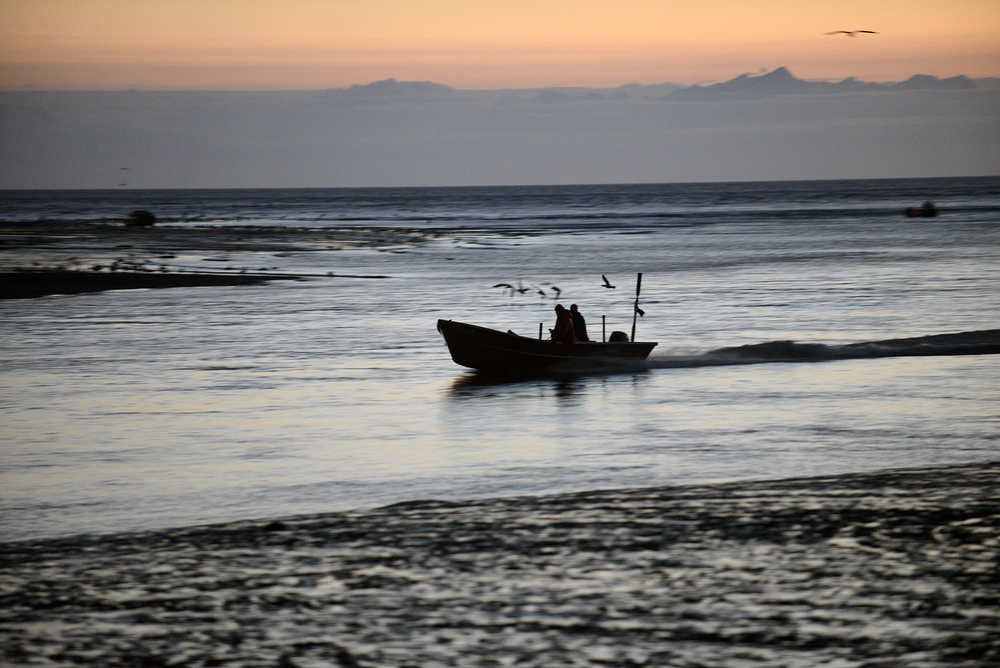The commercial Kenai River sockeye fishery could have its first regular finish in half a decade as long as Alaska Department of Fish and Game managers don’t renew king salmon conservation measures they loosened two weeks prior.
The commercial Kenai River sockeye fishery lasts until Aug. 15, with only a few days of openings allowed under the management plan. Biologists and managers in the area Alaska Department of Fish and Game, are carefully considering whether to reinstate the same king salmon related restrictions they dropped on July 24, which would potentially leave thousands of fish and hundreds of thousands of dollars in the water.
The Kenai king salmon management plan ties certain commercial restrictions to chinook projections. In July, if the in-river projection of kings dips below 22,500 fish, the commercial sockeye fishery is limited to 36 hours of fishing time while the sport fishery is limited to one un-baited hook.
On July 24, with an upper in-river projection of more than 25,000 kings, setnetters were allowed additional fishing time and the sport fishery was opened to bait for kings.
The sport fishery for kings closed on July 31.
In August, the management language changes so that if escapement is projected to be fewer than 22,500 Kenai kings, setnetters are limited to 36 hours for the month. With three periods so far on Aug. 1, Aug. 2, and Aug. 5, commercial fishermen will have already clocked 45 hours in August.
Assistant area management biologist Jason Pawluk said Fish and Game’s escapement projections straddle the 22,500-trigger line depending on how they’re measured.
“Right now we’re projecting 20,700 if we consider that the run is three days early,” Pawluk said. “If we consider the run on time, the projected escapement is 24,100.”
The Kenai River sonar counter at Mile 14 has already exceeded the lower end of the escapement goal, measuring 17,622 as of Aug. 4, which exceeds 2014 by 7,000 fish as of the same date and more than doubles the same date run size from 2013.
The management plan doesn’t specify when Fish and Game must make the call on king salmon-related restrictions; it only specifies that managers may do so between Aug. 1 and Aug. 15.
The plan also gives no guidance on whether the restriction to 36 hours of fishing time will incorporate the hours already fished for the month of August, and therefore potentially close the entire fishery retroactively.
Kenai area commercial manager Pat Shields said Fish and Game’s legal department and the management at the Anchorage ADFG office are currently reviewing this aspect of the management plan.
The distinction is critical as the commercial fishery’s August hours have already been used were they to be limited to 36 hours. Pawluk said the longer Fish and Game waits to make the call, the less effect it will have on the commercial fishery.
“When do you make that call?” he said. “As the assistant, I see we have an on-time run, we are seeing our projections drop. The department is going to analyze those sonar counts over the next few days. The commercial fishery ends Aug 15, but the Aug 10-15 only allows for regular openers on the 13th. We’re running out of time to have a big drastic change. As each day goes by, the effect of that management action is very little.”
So far, the Kenai sockeye run has been lackluster, with none of the usual surges. Management still hopes that the run will have a strong finish.
As of Aug. 2, ADFG’s sonar has counted 968,105 sockeye salmon towards a minimum in-river goal of 1 million. Between 2010 and 2014, the average count through Aug. 2 is 1.24 million.
“The run timing is still late,” said Shields. “Right now, we still don’t know if we’ll make it to forecast of 3.6 million (total Kenai sockeye run). The unusual thing about this, and this isn’t super abnormal, is that we haven’t had one or two really big days. The fish have bled in at a steady pace.”
Shields holds out for a late run, but commercial fishermen on the Kenai River are less optimistic, already pulling the gear from fishing sites according to setnetter Andy Hall.
“It wasn’t a great season,” said Hall. “I think the handcuffs put on the commercial manager (Shields) hit the east side pretty hard.
To make the most of the available catch, fishermen will need the remaining fishing time. Only Aug. 6, 8, 9, 10, and 13 are left open for fishing under the current unencumbered commercial management plan.
Though the numbers are unimpressive overall, sockeye are not yet tapering off, according to Shields.
In total, the commercial sockeye harvest in August has yielded 242,000 fish during 15-hour periods on Aug. 1 and 2, with another 15-hour period scheduled for Aug. 5.
At a conservative average of six pounds per fish, and a reported ex-vessel price of $1.35 to $1.50 per pound, the total ex-vessel value for the Kenai River commercial sockeye harvest only in the first three days of August is between $1.96 million and $2.19 million.
Only two triggers can end the commercial sockeye fishery prior to its scheduled Aug. 15 closure.
Guidelines proscribe a closure if the drift and setnet fleets have two consecutive fishing periods that yield less than 1 percent of the total harvest. Representing more than 10 percent of the entire season, the harvest totals in the first two periods in August indicate that such a closure is unlikely, though Shields said he’s keeping close watch on daily harvest totals.
As of Aug. 3, the total Central Cook Inlet harvest was 2.1 million, making the 1 percent cutoff about 21,000. The most recent opener on Aug. 2 yielded a harvest of 106,249, and Aug. 1 yielded 104,863.
The commercial nets caught 256 and 216 king salmon on the same dates, respectively, with a fraction of those bound for the Kenai River.
DJ Summers can be reached at daniel.summers@alaskajournal.com

